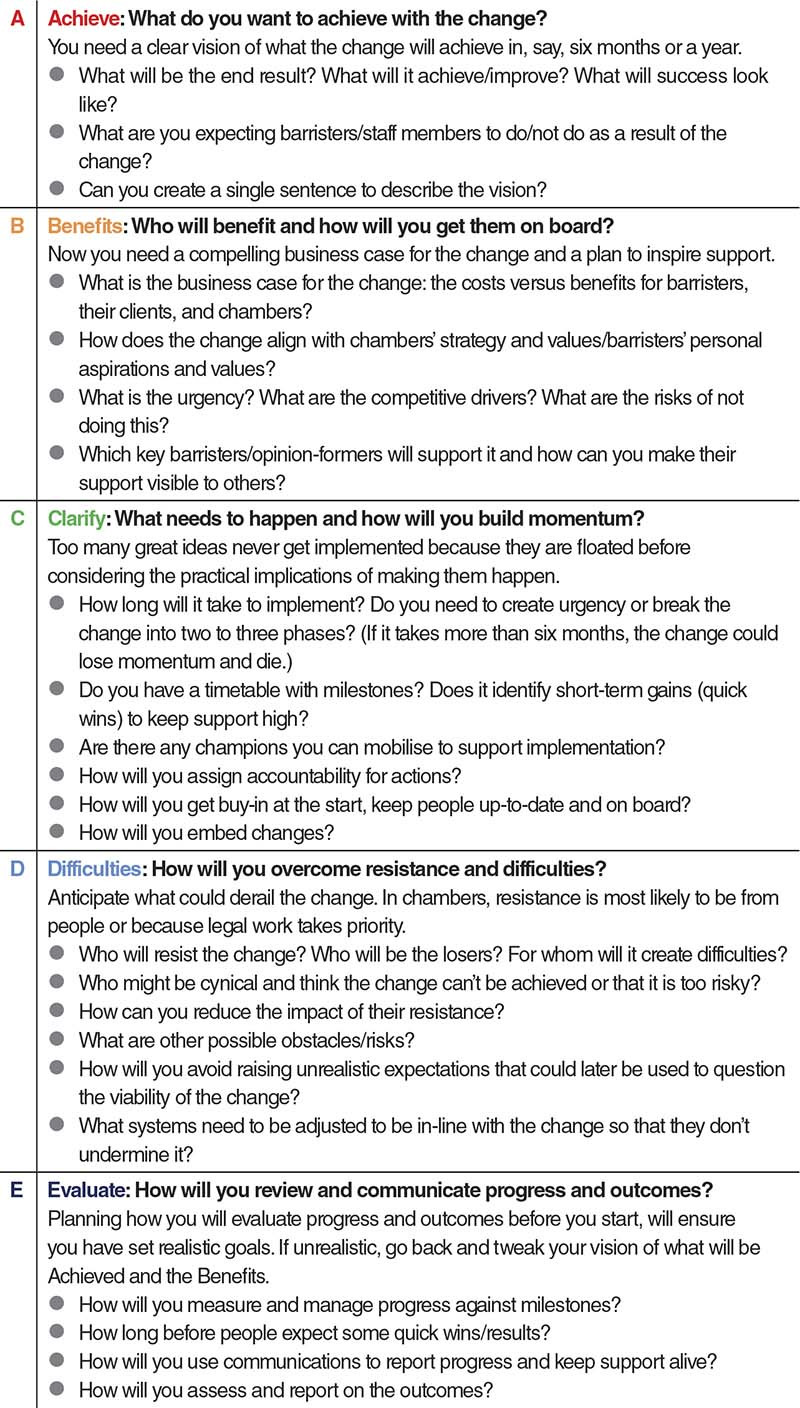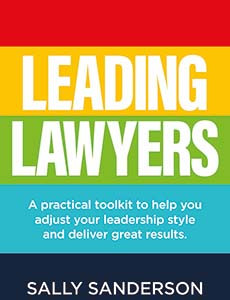*/

One of the hardest things to do when leading bright, driven barristers, is to get them to ‘buy into’ change for the collective good. It is the dilemma that many practice managers and heads of chambers experience, just like leaders in law firms. First, it is difficult to divert attention away from their clients. Second, they can marshal considerable intellect to undermine proposals and third, even when there is enthusiasm for change, there is still the challenge of implementation. Leading change in chambers is not for the faint-hearted.
Based on my work with law firms over many years, I have developed an approach to help leaders adapt their leadership style so that they:
The approach can work in chambers too.
Why is it we find some people so much easier to influence than others? People we may perceive as ‘difficult’ are often just different from us and things can spiral downwards quickly. You might ignore them, or get irritated, or not listen with an open-mind – all of which guarantees the person feels misunderstood or excluded and resistance then hardens. I witnessed a new HR consultant trying to influence a chief executive. She was a tough, no-nonsense personality and made a watertight business case for implementing a change in the way people were rewarded. However, she did not register his discomfort and didn’t sense his chief concern that it would make him very unpopular. He had different values and priorities to her and blocked the proposal.
It is far easier to build trust with someone who is ‘like you’ as plenty of research has shown (see Influence by Dr Robert B Cialdini). Neuroscience reveals that our caveperson brain feels safe with people like us; we unconsciously trust them more (see Your Brain at Work by Dr David Rock). Leaders can use insights from personality profiling to bridge differences and create trust. These tools help you understand your own style and the impact it has on others, and then learn to adjust your approach when listening to and influencing people unlike you. Some of this we might do instinctively – for example, tempering our enthusiasm with a cynic. However, we can take this to a higher level if we identify different personality styles and their corresponding buzz words that motivate or irritate, their likely values, their preferred pace for a conversation, and how comfortable they are likely to be with change. Once you fully understand them and their perspective, it is easier to influence using the feel/felt/found technique based on social proof: I can see why you feel/think [summarise empathetically their perspective], other members of chambers/other chambers felt/thought that too when it [the change] was first proposed, but what they found was [describe their experience that proves the change works]. Everyone needs a tailored approach; it is worth the investment when you anticipate resistance to change.
Communicating your vision clearly and planning implementation sounds simple, yet in my coaching work I noticed that leaders often miss out key parts of a leadership conversation and this is also linked to personality. Some people are big picture thinkers or like to inspire but don’t bother with the detailed plans, others are great at planning, but fail to inspire. Based on this experience and insights from psychometric feedback, I developed the ABCDE model which helps leaders cover it all.
This approach can be used by leaders in many different situations. It is covered in detail in Leading Lawyers, but here it is as a checklist of questions to consider when planning a change, including planning for resistance which is covered under Difficulties to avoid (see above).
For large change projects, more detailed planning will be required, but using this checklist ensures things don’t get forgotten at the outset which could undermine your efforts. Combined with adapting your style to win trust, you can approach implementing change with more confidence, even when you are asking people to make changes that could be distracting or unsettling for them.


Packed with real-life inspiring examples, ready-made tools and memorable tips, Leading Lawyers includes tips on perfecting your leadership style, working with different personalities and the ABCDE toolkit. Although focused on law firms, there are many tips relevant to anyone working with bright people in chambers.

One of the hardest things to do when leading bright, driven barristers, is to get them to ‘buy into’ change for the collective good. It is the dilemma that many practice managers and heads of chambers experience, just like leaders in law firms. First, it is difficult to divert attention away from their clients. Second, they can marshal considerable intellect to undermine proposals and third, even when there is enthusiasm for change, there is still the challenge of implementation. Leading change in chambers is not for the faint-hearted.
Based on my work with law firms over many years, I have developed an approach to help leaders adapt their leadership style so that they:
The approach can work in chambers too.
Why is it we find some people so much easier to influence than others? People we may perceive as ‘difficult’ are often just different from us and things can spiral downwards quickly. You might ignore them, or get irritated, or not listen with an open-mind – all of which guarantees the person feels misunderstood or excluded and resistance then hardens. I witnessed a new HR consultant trying to influence a chief executive. She was a tough, no-nonsense personality and made a watertight business case for implementing a change in the way people were rewarded. However, she did not register his discomfort and didn’t sense his chief concern that it would make him very unpopular. He had different values and priorities to her and blocked the proposal.
It is far easier to build trust with someone who is ‘like you’ as plenty of research has shown (see Influence by Dr Robert B Cialdini). Neuroscience reveals that our caveperson brain feels safe with people like us; we unconsciously trust them more (see Your Brain at Work by Dr David Rock). Leaders can use insights from personality profiling to bridge differences and create trust. These tools help you understand your own style and the impact it has on others, and then learn to adjust your approach when listening to and influencing people unlike you. Some of this we might do instinctively – for example, tempering our enthusiasm with a cynic. However, we can take this to a higher level if we identify different personality styles and their corresponding buzz words that motivate or irritate, their likely values, their preferred pace for a conversation, and how comfortable they are likely to be with change. Once you fully understand them and their perspective, it is easier to influence using the feel/felt/found technique based on social proof: I can see why you feel/think [summarise empathetically their perspective], other members of chambers/other chambers felt/thought that too when it [the change] was first proposed, but what they found was [describe their experience that proves the change works]. Everyone needs a tailored approach; it is worth the investment when you anticipate resistance to change.
Communicating your vision clearly and planning implementation sounds simple, yet in my coaching work I noticed that leaders often miss out key parts of a leadership conversation and this is also linked to personality. Some people are big picture thinkers or like to inspire but don’t bother with the detailed plans, others are great at planning, but fail to inspire. Based on this experience and insights from psychometric feedback, I developed the ABCDE model which helps leaders cover it all.
This approach can be used by leaders in many different situations. It is covered in detail in Leading Lawyers, but here it is as a checklist of questions to consider when planning a change, including planning for resistance which is covered under Difficulties to avoid (see above).
For large change projects, more detailed planning will be required, but using this checklist ensures things don’t get forgotten at the outset which could undermine your efforts. Combined with adapting your style to win trust, you can approach implementing change with more confidence, even when you are asking people to make changes that could be distracting or unsettling for them.


Packed with real-life inspiring examples, ready-made tools and memorable tips, Leading Lawyers includes tips on perfecting your leadership style, working with different personalities and the ABCDE toolkit. Although focused on law firms, there are many tips relevant to anyone working with bright people in chambers.


Chair of the Bar reflects on 2025
AlphaBiolabs has donated £500 to The Christie Charity through its Giving Back initiative, helping to support cancer care, treatment and research across Greater Manchester, Cheshire and further afield
Q&A with criminal barrister Nick Murphy, who moved to New Park Court Chambers on the North Eastern Circuit in search of a better work-life balance
Revolt Cycling in Holborn, London’s first sustainable fitness studio, invites barristers to join the revolution – turning pedal power into clean energy
Rachel Davenport, Co-founder and Director at AlphaBiolabs, reflects on how the company’s Giving Back ethos continues to make a difference to communities across the UK
By Marie Law, Director of Toxicology at AlphaBiolabs
Are you ready for the new way to do tax returns? David Southern KC explains the biggest change since HMRC launched self-assessment more than 30 years ago... and its impact on the Bar
Professor Dominic Regan and Seán Jones KC present their best buys for this holiday season
Marking one year since a Bar disciplinary tribunal dismissed all charges against her, Dr Charlotte Proudman discusses the experience, her formative years and next steps. Interview by Anthony Inglese CB
Little has changed since Burns v Burns . Cohabiting couples deserve better than to be left on the blasted heath with the existing witch’s brew for another four decades, argues Christopher Stirling
Pointillism, radical politics and social conscience. Review by Stephen Cragg KC